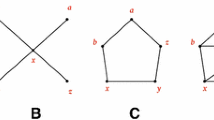Abstract
The object of this paper is to demonstrate in economic terms the equivalence of the problem of aggregation in input-output analysis with coalition and bargaining problems. Depending on the specific norm for aggregation it is shown that the aggregation criterion and the coalition forming criterion in an n-person game leads to a broadly similar situation in the market sense given that the market operates to that criterion. It is also shown that a mathematical analogue to this formulation may be obtained via the techniques of geometric programming.
Similar content being viewed by others
References
A.Ghosh and H.Sarkar (1972), ‘An input-output matrix as a spatial configuration’, Economics of Planning, Oslo.
A. Ghosh and P.K. Bugumbe (1981), ‘Computation of an optimal ordering for an input-output matrix by an application of dynamic Programming’, Economics of Planning 17, No. 1.
A. Ghosh (1985), ‘Equivalence of the optimal ordering problem with maximum row-col. correlation’, Economics of Planning 19.
A. Ghosh (1985), ‘A characterisation of the heuristic solution of the optimal ordering problem of an input-output matrix as a Nash Point with some observation on the ordering problem as a game’, Economics of Planning 19.
R.J. Duffin, E.L. Peterson, C. Zenner (1967), Geometric Programming, Wiley.
Author information
Authors and Affiliations
Rights and permissions
About this article
Cite this article
Ghosh, A. A formulation of the aggregation problem in terms of coalition and bargaining theory. Econ Plann 23, 97–116 (1990). https://doi.org/10.1007/BF00312929
Issue Date:
DOI: https://doi.org/10.1007/BF00312929




